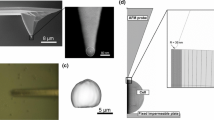Abstract
Chondrocytes, the cells in articular cartilage, exhibit solid-like viscoelastic behavior in response to mechanical stress. In modeling the creep response of these cells during micropipette aspiration, previous studies have attributed the viscoelastic behavior of chondrocytes to either intrinsic viscoelasticity of the cytoplasm or to biphasic effects arising from fluid–solid interactions within the cell. However, the mechanisms responsible for the viscoelastic behavior of chondrocytes are not fully understood and may involve one or both of these phenomena. In this study, the micropipette aspiration experiment was modeled using a large strain finite element simulation that incorporated contact boundary conditions. The cell was modeled using finite strain incompressible and compressible elastic models, a two-mode compressible viscoelastic model, or a biphasic elastic or viscoelastic model. Comparison of the model to the experimentally measured response of chondrocytes to a step increase in aspiration pressure showed that a two-mode compressible viscoelastic formulation accurately captured the creep response of chondrocytes during micropipette aspiration. Similarly, a biphasic two-mode viscoelastic analysis could predict all aspects of the cell’s creep response to a step aspiration. In contrast, a biphasic elastic formulation was not capable of predicting the complete creep response, suggesting that the creep response of the chondrocytes under micropipette aspiration is predominantly due to intrinsic viscoelastic phenomena and is not due to the biphasic behavior.
Similar content being viewed by others
References
Baaijens, F. An U-ALE formulation of 3-D unsteady viscoelastic flow. Int. J. Numer. Methods Eng. 36:1115–1143, 1993.
Bachrach, N., W. Valhmu, E. Stazzone, A. Ratcliffe, W. Lai, and V. Mow. Changes in proteoglycan synthesis of chondrocytes in articular cartilage are associated with the time-dependent changes in their mechanical environment. J. Biomech. 28:1561–1570, 1995.
Guilak, F. Compression-induced changes in the shape and volume of the chondrocyte nucleus. J. Biomech. 28:1529–1542, 1995.
Guilak, F., G. Erickson, and H. Ting-Beall. The effects of osmotic stress on the viscoelastic and physical properties of articular chondrocytes. Biophys. J. 82:720–727, 2002.
Guilak, F., and V. Mow. The mechanical environment of the chondrocyte: A biphasic finite element model of cell–matrix interactions in articular cartilage. J. Biomech. 33:1663–1673, 2000.
Guilak, F., R. L. Sah, and L. A. Setton. Physical Regulation of Cartilage Metabolism, In: Mow VC, Hayes W. C., Editors. Basic Orthopaedic Biomechanics. 2nd ed. Philadelphia: Lippincott-Raven; 1997, p. 179–207.
Haider, M., and F. Guilak. An axisymmetric boundary integral model for incompressible linear viscoelasticity: Application to the micropipette aspiration contact problem. J. Biomech. Eng. 122:236–244, 2000.
Haider, M., and F. Guilak. An axisymmetric boundary integral model for assessing elastic cell properties in the micropipette aspiration contact problem. J. Biomech. Eng. 124:586–595, 2002.
Hochmuth, R. Micropipette aspiration of living cells. J. Biomech. 33:15–22, 2000.
Hung, C., K. Costa, and X. Guo. Apparent and transient mechanical properties of chondrocytes during osmotic loading using triphasic theory and afm indentation. ASME Bioeng. Conf. BED-50:625–626, 2001.
Jones, W., H. Ting-Beall, G. Lee, S. Kelley, R. Hochmuth, and F. Guilak. Alterations in the young’s modulus and volumetric properties of chondrocytes isolated from normal and osteoarthritic human cartilage. J. Biomech. 32:119–127, 1999.
Koay, E., A. Shien, and K. Athanasiou. Creep indentation of single cells. J. Biomech. Eng. 125(3):334–341, 2003.
Mow, V., S. Kuei, W. Lai, and C. Armstrong. Biphasic creep and stress relaxation of articular cartilage in compression: Theory and experiments. J. Biomech. Eng. 102:73–84, 1980.
Mow, V., D. Sun, X. Guo, C. Hung, and W. Lai. Chondrocyte-extracellular matrix interactions during osmotic swelling. ASME Bioeng. Conf. BED42:133–134, 1999.
Poole, R. Imbalances of Anabolism and Catabolism of Cartilage Matrix Components in Osteoarthritis. In: Keuttner, K. E., Goldberg, V. M., eds. Osteoarthritic Disorders. AAOS Press, Rosemont, Illinois, USA, 1995, p. 247–260.
Sato, M., D. Theret, L. Wheeler, N. Ohshima, and R. Nerem. Application of the micropipette technique to the measurement of cultured porcine aortic endothelial cell viscoelastic properties. J. Biomech. Eng. 112:263–268, 1990.
Sengers, B., C. Oomens, and F. Baaijens. An integrated finite element approach to mechanics, transport and biosynthesis in tissue engineering. J. Biomech. Eng. 126:82–91, 2004.
Setton, L., W. Zhu, and V. Mow. The biphasic poroviscoelastic behavior of articular cartilage: Role of the surface zone in governing the compressive behavior. J. Biomech. 26:581–592, 1993.
Shin, D., and K. Athanasiou. Cytoindentation for obtaining cell biomechanical properties. J. Orthop. Res. 17:880–890, 1999.
Theret, D., M. Levesque, M. Sato, R. Nerem, and L. Wheeler. The application of a homogeneous half-space model in the analysis of endothelial cell micropipette measurements. J. Biomech. Eng. 110:190–199, 1988.
Trickey, W., F. Baaijens, T. Laursen, L. Alexopoulos, and F. Guilak. Determination of the Poisson’s ratio of the cell: Recovery properties of chondrocytes after release from complete micropipette aspiration. J. Biomech. (Submitted), 2004a.
Trickey, W., G. Lee, and F. Guilak. Viscoelastic properties of chondrocytes from normal and osteoarthritic human cartilage. J. Orthop. Res. 18:891–898, 2000.
Trickey, W., T. Vail, and F. Guilak. The role of the cytoskeleton in the viscoelastic properties of human articular chondrocytes. J. Orthop. Res. 22:131–139, 2004b.
Wilkes, R., and K. Athanasiou. The intrinsic incompressibility of osteoblast-like cells. Tissue Eng. 2:167–181, 1996.
Wu, J., W. Herzog, and M. Epstein. Modelling of location- and time-dependent deformation of chondrocytes during cartilage loading. J. Biomech. 32:563–572, 1999.
Author information
Authors and Affiliations
Rights and permissions
About this article
Cite this article
Baaijens, F.P.T., Trickey, W.R., Laursen, T.A. et al. Large Deformation Finite Element Analysis of Micropipette Aspiration to Determine the Mechanical Properties of the Chondrocyte. Ann Biomed Eng 33, 494–501 (2005). https://doi.org/10.1007/s10439-005-2506-3
Received:
Accepted:
Issue Date:
DOI: https://doi.org/10.1007/s10439-005-2506-3




